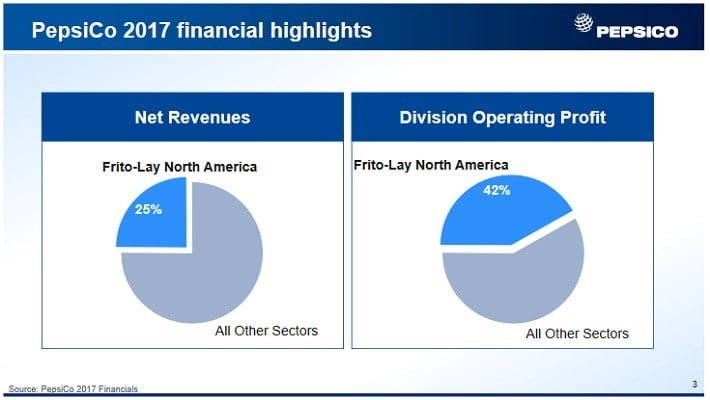Investors looking for stable dividend stocks, should consider the consumer goods industry. As opposed to more volatile industries like technology or industrial manufacturing, the top consumer goods companies can keep earnings intact, in good economies and bad.
Check out our H2 hedge fund letters here.
ValueWalk readers can click here to instantly access an exclusive $100 discount on Sure Dividend’s premium online course Invest Like The Best, which contains a case-study-based investigation of how 6 of the world’s best investors beat the market over time.
Consistent profitability helps them sustain their dividends, and grow them on a regular basis. We have compiled a list of five stocks, all in the consumer goods industry, which have announced 10%+ dividend increases so far in 2018. All five stocks on this list have impressive histories of dividend growth.
The first three stocks mentioned in this article are members of the Dividend Aristocrats, a group of 53 stocks in the S&P 500 Index, with 25+ years of consecutive dividend increases. You can see all 53 Dividend Aristocrats here.
These stocks have many attractive qualities in common. They are all highly profitable, and generate impressive returns on capital. They also have pricing power. As a result, they can remain profitable enough to sustain their dividend growth each year moving forward.
With top brands in their respective industries, catalysts for future growth, and strong dividend raises each year, these five stocks should be on the radar for dividend growth investors.
Dividend Growth Stock #1: PepsiCo (PEP)
- 2018 Dividend Increase: 15%
Food and beverage giant PepsiCo is a top choice for dividend growth investors. For example, on February 13th, PepsiCo raised its dividend by 15%, and also announced a new $15 billion share repurchase program.
With the dividend increase, PepsiCo has now raised its dividend payout for 46 consecutive years.
PepsiCo has a large portfolio, which is nearly evenly split between food and beverages.
Some of the company’s major brands include Pepsi and Mountain Dew sodas, as well as non-sparkling beverages like Pure Leaf, Tropicana, Gatorade, and bottled water. In addition to PepsiCo’s core beverage brands, it also has a large snacks business under the Frito-Lay brand. The company has also built a portfolio of healthier foods, including Quaker, Naked, and Sabra.
The food segment is the key area of growth for PepsiCo, led by its Frito-Lay segment.
Source: 2018 CAGNY Conference Presentation, page 3
PepsiCo performed well in 2017. In the fourth quarter, organic revenue increased 2% year over year. Food and snacks led the way for PepsiCo, with 2% volume growth, compared with a 2% decline for beverage volumes. Frito-Lay North America generated 3% volume growth, and 5% organic revenue growth in the fourth quarter.
For the full year, PepsiCo had adjusted earnings-per-share of $5.23, which increased 9% from 2016. Organic revenue increased 2.3% for the year. Thanks to the company’s strong brands and global reach, 2018 is expected to be another strong year.
Food and snacks will continue to be a major growth catalyst. The environment for soda is worsening—due to shifting consumer preferences, U.S. soda consumption has steadily declined for over a decade.
Fortunately, the snacks portfolio continues to grow at a high rate, and is taking market share.
Source: 2018 CAGNY Conference Presentation, page 6
PepsiCo has a particularly attractive growth opportunity in emerging markets like China, Africa, India, and Latin America. For example, in the fourth quarter, PepsiCo realized 6% organic revenue growth in the Europe/Sub-Saharan Africa region, and the Asia/Middle East/Africa region. Organic revenue also increased 3% in Latin America. These emerging economies helped offset the 3% organic revenue decline in North America.
After the recent 15% dividend increase, PepsiCo has a dividend yield of 3.4%, which is nearly twice the average dividend yield of the S&P 500 Index. This makes PepsiCo a great holding for income investors.
Dividend Growth Stock #2: Clorox (CLX)
- 2018 Dividend Increase: 14%
Like PepsiCo, Clorox is a Dividend Aristocrat. Clorox recently extended its dividend growth streak to 41 years, with a 14% dividend increase on February 13th. The recent dividend increase elevates Clorox’s dividend yield to 3%.
Clorox has a diversified portfolio of strong brands. Its most popular brands include Clorox, Pine-Sol, Glad, Kingsford, Hidden Valley, Brita, Burt’s Bees, Fresh Step, and RenewLife.
Clorox generates annual sales of $6 billion. Over 80% of the company’s global sales are derived from products that hold either the #1 or #2 market share in their respective categories.
Source: 2017 Analyst Day Presentation, page 11
Clorox’s products enjoy strong demand, which leads to volume growth, while its top brand positioning allows for pricing power. Volume growth and price increases provide significant growth for Clorox each year. For example, the company had sales and earnings-per-share growth rates of 4% and 9% in fiscal 2017, respectively. Volumes rose 6% in 2017.
So far in 2018, business conditions remain favorable for Clorox. In the most recent quarter, sales and volumes increased 1%. Despite margin pressure from higher raw materials costs, adjusted earnings per share increased 8% from the same quarter a year ago.
Clorox expects 2018 to be another good year. Full-year sales are expected to increase as much as 3%, while earnings-per-share are expected to rise 17%, thanks in large part to tax reform.
Over the long-term, Clorox’s growth will be fueled mostly by product innovation, which is key to the company’s success. Clorox maintains a goal of adding 3% to annual sales from product innovation.
E-commerce is another promising growth catalyst. Clorox has generated 37% annual e-commerce growth over the past three years. E-commerce sales were $225 million in fiscal 2017, and Clorox expects e-commerce sales to reach $500 million by 2020.
Clorox is a very shareholder-friendly company. It returns significant amounts of cash to shareholders each year, through dividends and share buybacks.
Source: 2017 Analyst Day Presentation, page 86
Clorox’s dividend is highly secure, with room for continued increases going forward. Based on expected 2018 earnings per share of $6.17 to $6.37, and the new dividend rate of $3.84, Clorox will have a dividend payout ratio of 60% to 62% this year. Even after the recent 14% dividend raise, Clorox easily covers its dividend payments.
Dividend Growth Stock #3: Hormel Foods (HRL)
- 2018 Dividend Increase: 10%
Not only is Hormel a Dividend Aristocrat, but it is also a Dividend King, an even more exclusive group of stocks with 50+ consecutive years of dividend increases. You can see all the Dividend Kings here.
There are just 23 Dividend Kings, including Hormel.
Source: 2018 CAGNY Conference Presentation, page 6
Hormel has a diverse product portfolio. Some of its major brands include Skippy, Jennie-O, Spam, Hormel, and Dinty Moore, among others.
This is a more challenging time for Hormel than usual, because the company’s large Jennie-O segment is under pressure. Record turkey production has caused significant price deflation. As a result, operating profit in the Jennie-O segment declined by 27% in the most recent quarter.
Fortunately, Hormel still generated 27% earnings-per-share growth last quarter. Despite the pressure in its turkey segment, Hormel continues to generate growth, which is fueled by acquisitions. Mergers and acquisitions have has been the biggest contributor to Hormel’s growth over the past few years.
Source: 2017 Barclays Global Consumer Staples Conference, page 15
In 2015, Hormel acquired Applegate Farms for $775 million. Applegate produces natural and organic prepared meats, such as deli meat, bacon, and hot dogs. It is the number one brand in natural and organic meats.
Over the past year, the company has made several bolt-on acquisitions. For example, Hormel acquired Fontanini Italian Meats and Sausages, to expand its refrigerated foods. Hormel also acquired Ceratti, a branded meats business in Brazil.
Separately, on October 31st, Hormel announced it will purchase Columbus Manufacturing, a premium deli meat and salami manufacturer. Hormel expects the acquisition to increase annual sales by approximately $300 million.
For 2018, Hormel expects earnings-per-share of $1.81 to $1.95. At the midpoint, earnings are expected to rise 20% from fiscal 2017. Such strong earnings growth allows the company to increase its dividend at high rates.
Source: 2018 CAGNY Conference Presentation, page 28
On January 10th, Hormel raised its dividend by 10%, to $0.75 per share on an annual basis.
The forward dividend yield for Hormel stock is 2.3%. Hormel is not a high-yield dividend stock, but it makes up for this with high dividend growth rates. Hormel has increased its dividend each year, for more than five decades.
Dividend Growth Stock #4: Home Depot (HD)
- 2018 Dividend Increase: 16%
Retailers are under heavy pressure these days, from the rise of e-commerce. Internet-based retailers like Amazon (AMZN) are rapidly taking share from brick-and-mortar retailers. There have been multiple retail bankruptcies over the past year, with more to come.
That said, certain pockets of the retail industry have managed to insulate themselves from e-commerce competitors. One of the areas least vulnerable to Amazon is home improvement retailers such as Home Depot.
The reason is simple—home renovation projects are complex. Consumers appreciate the ability to view products in person before buying. And, qualified staff members at Home Depot can help answer questions and provide guidance to shoppers.
As a result, Home Depot continues to thrive, even with Amazon rapidly taking share in the retail industry.
In 2017, Home Depot’s sales grew 6.7%, to $100.9 billion. Diluted earnings per share grew 13% to $7.29. Sales and earnings both set company records. For 2018 and beyond, the company is investing to build its own e-commerce platform.
Source: 2017 Annual Shareholder Meeting, page 16
Online sales grew 21% in the fourth quarter and 21.5% in fiscal 2017, and now represent 6.7% of total sales. Nearly half of online orders in the U.S. were picked up in stores, which is a testament to the value of physical stores as it pertains to fulfillment.
In addition, the U.S. economy continues to grow, as does the housing market. Wages and home prices are rising. These tailwinds should remain intact going forward, as household formation and home prices continue to rise, while unemployment remains well below 5%.
These trends are all positive for Home Depot, as they encourage homeowners to invest in their homes through discretionary projects, ongoing maintenance, and repairs.
For 2018, Home Depot expects sales growth of approximately 6.5%, along with comparable sales growth of 5.0%. Excluding the benefit of a 53rd week, Home Depot expects impressive earnings growth, of 25% for 2018.
Home Depot’s 16% dividend increase brings the new annualized dividend rate to $4.12 per share. Home Depot stock has a forward dividend yield of 2.3%, which may not be very appealing for investors interested in high dividend yields.
However, Home Depot’s dividend yield still beats the S&P 500 Index average dividend yield, which is currently below 2%. And, Home Depot’s dividend will rise quickly. It has a clear path to 10%+ dividend increases each year, moving forward.
Dividend Growth Stock #5: Foot Locker (FL)
- 2018 Dividend Increase: 11%
Foot Locker is a prime example of a retail stock under heavy pressure from the threat of e-commerce. Foot Locker shares have lost nearly half their value in the past one year. Sentiment has clearly turned much more negative, as investors face the prospect of declining mall traffic and consumers flocking to the Internet to buy shoes and other athletic apparel.
However, despite the steep drop in Foot Locker’s share price, the company has remained solidly profitable. It has even continued to grow revenue in this harsh operating climate.
For example, on March 2nd Foot Locker released fourth-quarter earnings. Quarterly revenue of $2.21 billion rose 4.7% from the same quarter the previous year. Excluding currency impacts, total sales increased 2.0%.
One concern is that comparable sales declined 3.7%. Comparable sales reflects performance at stores open at least one year. In addition, adjusted earnings-per-share fell 17% in 2017, versus the previous year.
Last year ended a multi-year streak of steady sales and earnings growth for Foot Locker.
Source: 2016 Annual Report, page 6
Last year was a period of elevated investment for Foot Locker, but this was necessary to fuel a turnaround. Foot Locker has to adjust to a new, more difficult retail environment. Investments are focused on building its digital business, to compete with Internet retailers.
For 2018, Foot Locker expects comparable sales to be from flat to an increase in the low single-digit range. Earnings-per-share could return to growth, due to comparable sales growth, as well as share repurchases. In 2017, Foot Locker utilized $467 million to repurchase 12.4 million shares.
On February 21st, Foot Locker raised its quarterly dividend by 11%, to $0.345 per share. On an annualized basis, Foot Locker’s new dividend payout of $1.38 per share, represents a forward dividend yield of 3.4%. This is a solid dividend yield, particularly for a company with double-digit dividend increases.
Foot Locker can continue to raise its dividend going forward, because it has a low dividend payout ratio. Based on adjusted earnings-per-share of $3.99 for 2017, the forward annual dividend payout of $1.38 represents a payout ratio of 35%.
Final Thoughts
The consumer products industry is undergoing significant changes, due to the rise of e-commerce. As a result, investors should focus on companies with strong brands, and pricing power. This allows them to remain highly profitable, and raise their dividends each year.
The five stocks on this list all have top brands in their respective industries. They have strong profitability, which allows them to buy back stock and grow their dividends by 10%+. As a result, the list has strong candidates for dividend growth investors.
Thanks for reading this article. Please send any feedback, corrections, or questions to [email protected].
Article by Sure Dividend
ValueWalk readers can click here to instantly access an exclusive $100 discount on Sure Dividend’s premium online course Invest Like The Best, which contains a case-study-based investigation of how 6 of the world’s best investors beat the market over time.














